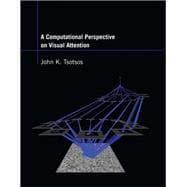
| Preface | p. xi |
| Acknowledgments | p. xv |
| Attention-We All Know What It Is | p. 1 |
| But Do We Really? | p. 1 |
| Moving Toward a Computational Viewpoint | p. 7 |
| What Is Attention? | p. 10 |
| Computational Foundations | p. 11 |
| Attempting to Understand Visual Processing Capacity | p. 11 |
| The Language of Computation | p. 14 |
| Capacity Limits and Computational Complexity | p. 16 |
| Human Perception/Cognition and Computation | p. 18 |
| The Computational Complexity of Vision | p. 21 |
| Extending to Active Vision | p. 29 |
| Extending to Cognition and Action | p. 32 |
| Extending to Sensor Planning | p. 32 |
| Complexity Constrains Visual Processing Architecture | p. 33 |
| The Problems with Pyramids | p. 38 |
| Attention Is. … | p. 51 |
| Theories and Models of Visual Attention | p. 53 |
| The Elements of Visual Attention | p. 54 |
| A Taxonomy of Models | p. 59 |
| Other Relevant Ideas | p. 75 |
| Summary | p. 78 |
| Selective Tuning: Overview | p. 81 |
| The Basic Model | p. 82 |
| Saliency and Its Role in ST | p. 86 |
| Selective Tuning with Fixation Control | p. 88 |
| Differences with Other Models | p. 93 |
| Summary | p. 96 |
| Selective Tuning: Formulation | p. 97 |
| Objective | p. 97 |
| Representations | p. 98 |
| Neurons and Circuits for Selective Tuning | p. 106 |
| Selection | p. 114 |
| Competition to Represent a Stimulus | p. 121 |
| More on Top-Down Tracing | p. 122 |
| Inhibition of Return | p. 124 |
| Peripheral Priority Map Computation | p. 124 |
| Fixation History Map Maintenance | p. 125 |
| Task Guidance | p. 126 |
| Comparisons with Other Models | p. 127 |
| Summary | p. 131 |
| Attention, Recognition, and Binding | p. 133 |
| What Is Recognition? | p. 134 |
| What Is Visual Feature Binding? | p. 139 |
| Four Binding Processes | p. 141 |
| Binding Decision Process | p. 145 |
| Putting It All Together | p. 146 |
| Summary | p. 149 |
| Selective Tuning: Examples and Performance | p. 151 |
| P-Lattice Representation of Visual Motion Information | p. 151 |
| Priming | p. 153 |
| Results After a Single Feed-Forward Pass (Convergence Binding) | p. 160 |
| Results from a Single Feed-Forward Pass Followed by a Single Recurrent Pass (Full Recurrence Binding) | p. 164 |
| Attending to Multiple Stimuli (Type I Iterative Recurrence Binding) | p. 166 |
| Empirical Performance of Recurrence Binding (Localization) | p. 168 |
| Visual Search | p. 174 |
| Type II Iterative Recurrence Binding | p. 186 |
| Saliency and AIM | p. 187 |
| Summary | p. 190 |
| Explanations and Predictions | p. 193 |
| Explanations | p. 195 |
| Predictions with Experimental Support | p. 205 |
| Some Supporting Experiments | p. 211 |
| Summary | p. 231 |
| Wrapping Up the Loose Ends | p. 233 |
| The Loose Ends | p. 236 |
| Vision as Dynamic Tuning of a General-Purpose Processor | p. 247 |
| Final Words | p. 248 |
| Appendixes | p. 251 |
| A Few Notes on Some Relevant Aspects of Complexity Theory | p. 251 |
| Proofs of the Complexity of Visual Match | p. 255 |
| The Representation of Visual Motion Processes | p. 265 |
| References | p. 275 |
| Author Index | p. 297 |
| Subject Index | p. 305 |
| Table of Contents provided by Ingram. All Rights Reserved. |
The New copy of this book will include any supplemental materials advertised. Please check the title of the book to determine if it should include any access cards, study guides, lab manuals, CDs, etc.
The Used, Rental and eBook copies of this book are not guaranteed to include any supplemental materials. Typically, only the book itself is included. This is true even if the title states it includes any access cards, study guides, lab manuals, CDs, etc.